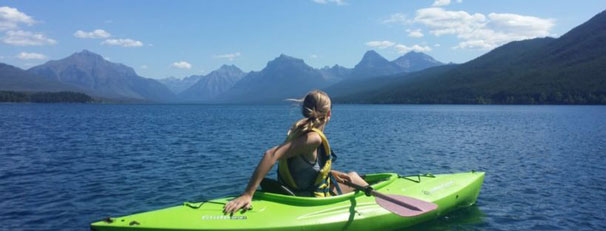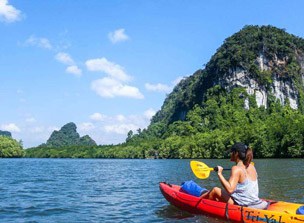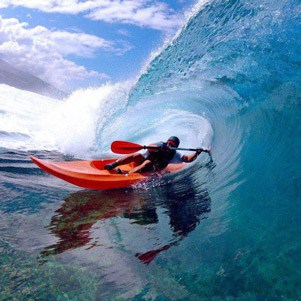You may be new to kayaking and think that all the thick clothing is for hitting the water in colder weather.
To a certain degree, this is correct, although you do need a set amount of protection when you are kayaking in warmer weather.
It does make a difference what you wear and when kayak fishing being a good example. You won’t be paddling, so your body won’t be as warm as if you were paddling. Not to mention when you get wet.

Cotton absorbs water and takes longer to dry so that you will feel uncomfortable. Finally, even if the day is overcast, you can still feel the effects of the sun, so that you will require sun protection.
We will show here all you need to know about what to wear kayaking. You can also learn what kayaking
gear you need to make sure you are comfortable and protected in warm weather or when the weather turns rough.
Kayak Clothing Guidelines
Here are some guidelines you should follow, regardless of weather conditions. When you follow these, you will follow the same sorts of rules that go with hiking. Dressing for durability, comfort, and protection are the primary factors.
- PFD: You always need to wear a life jacket or personal floatation device. In some areas, this is a regulation, and you can’t go out on the water without one. This is more important if it is a family event and even if you are using the best kayak for kids.
- Water Temperatures: The air temperature may be warm, yet you need to dress for the water temperature because this can be much colder.
- Layers: You will need to dress in layers, especially on the upper part of the body.
- Protection Against the Sun: Sunscreen won’t suffice on its own, so you will require clothing that comes with a UPF rated fabric. This will be more if you are using pedal kayaks where all your body is exposed.
- Avoid Cotton: Cotton remains wet, and the clothing you need is fast drying. When choosing your base layer, select clothing with wicking abilities, such as nylon or polyester. Wool can be a good option for insulation, though it does take longer to dry.
- Comfort: You will be sitting for extended periods, so you need comfortable clothes.
- Avoid Metal Fasteners: Metal zips and studs can corrode when exposed to water. Saltwater being even worse, so when you choose a dry bag for your gear, make sure this comes with plastic fittings.
What to Wear When Kayaking
When you decide what to wear kayaking, you will need to know the weather conditions beforehand, although this doesn’t mean you can go unprepared. Here, we will go through how to dress for kayaking or take it with you regardless of the conditions.
What Do You Wear Underneath a Wetsuit?
You may think a wet suit is too much when the weather is mild. However, you need to think about trying to climb in a wetsuit if you capsize. It is almost impossible, and you are dressing in case you are in the water. (Read What Do You Wear Underneath A Wetsuit)
It is a recommendation that unless you are in waters that are protected and inland, which are warm enough, you ought to be wearing a kayak wetsuit. In most cases, you have to consider water temps.
If these are below 60 degrees Fahrenheit, as you would generally find in cold weather, you need to consider the combined air and water temperatures.
If this combined air and the water temp is below 120 degrees Fahrenheit, you can get away with a dry suit.
If it is hot, you can opt for a sleeveless wetsuit, although these won’t hold the thin layer of water against your body to keep you warm.
In a cold water wetsuit, you can wear long underwear because these prevent any water from getting inside. When using a thinner neoprene suit, you can opt for a swimsuit as your waterproof underwear layer.

Sit-In Kayak Clothing
A kayak of this style can protect you from the water by the skirt you fasten around yourself. In the same manner, you may be able to wear quick-dry pants or board shorts as your legs will be out of the sun.
Tops will be the same in any kayak and do need long sleeves with a UPF rating for protection. Blends of spandex or Lycra are ideal because you can wear these comfortably under your wetsuit.
Outer layers will need to be light and breathable. Light water-resistant jackets are ideal, and you can keep a more water-resistant option in your bag.
Footwear also needs to be suitable for kayaking, so it doesn’t matter if you sit in, sit on, or a paddle kayak. Good footwear is essential, and one of the best is neoprene booties. You find these are waterproof, light, and offer lots of protection against rubbing, or if you stand on anything rough. (Find the Best Kayak Roof Rack for Cars Without Rails)
Protection from the Sun
Once you have begun to learn kayaking, you may see why sunglasses are so important. Even a hint of light across the water can be magnified, and it will cause you to squint. If this happens, you won’t have a good view of what is going on around you.
Once you have your shades, you ought to be wearing a wide-brimmed hat. Like other clothing, you should make sure it has a UPF rating. Hats can make things far more comfortable than just keeping the sun off your head.
When the sun is up, they can keep your shoulders and other parts of your body shaded.
Conclusion
You may be kayaking in milder weather, and you think it is safe to wear casual clothing. While it sounds nice, the first thing you must consider is that you remain warm and dry.
Besides this, and depending on where you are, there can be a huge difference between air and water temperatures.
Dressing for the worst can keep you safe, and in many instances, you will find the clothing you choose is more comfortable than grabbing flip-flops and shorts from the closet.





